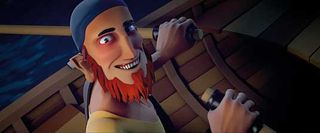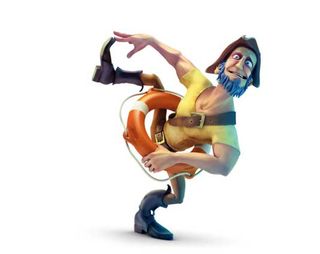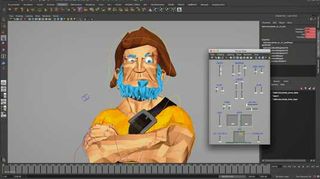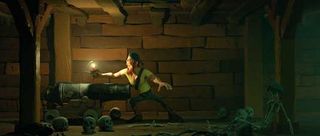How to make a 3D pirate movie in 10 days
Short film Booty Call was animated in 10 days by 16 animators from Europe and Kenny Roy, a director from LA. Find out how they managed it, and check out the finished version.
Anomalia is a training and networking platform for 3D animation, which started as an initiative to further educate Central European artists in modern 3D animation and filmmaking. Isaac Kerlow, formerly of Disney, and Kyle Balda, formerly of Pixar, delivered the first workshops in Prague in 2008; since then, Anomalia has provided a classroom experience every summer in Litomyšl, in the Czech Republic.
With a strong emphasis on project development and team collaboration, Booty Call tested the 16-strong team of student animators. "We try to offer unique topics every summer and to challenge ourselves with new things never done before in collaboration with experienced professionals," says executive producer David Toušek. "So when Kenny Roy talked to us and suggested a Short Film Making course to animate a short in 10 days, where animators could get into a challenging collaborative environment, we figured this was worth our effort."
We try to offer unique topics every summer and challenge ourselves with things never done before
Anomalia worked on the concept a year ahead of the course, and narrowed the idea down to a simple story; a down-and-out, second-tier pirate tries to steak treasure from another crew.
"Eventually, we spread the word out to the animation community across Europe and 16 very talented animators interested in the event. Then we set sail!" says Toušek.

Pirate copies
With the concept set, Anomalia began to design the main character of the pirate. They worked with character designer Jan Živocký, who gave them several inspiring ideas before they ended up with a pirate, called Babinsky. "At first, Babinsky looked like a wrestler in underwear," says Toušek. "But since Babinsky was supposed to be a character for the entire training, I wanted him to be strong, because I feel it’s easier to practise weight and charismatic personalities with a fuller character."
The animation style was a departure from Toušek’s personal style, which tends to lean toward classical puppetry: "We gave animators space to improvise and take their imagination through the roof. Just a couple days later, somebody started to push the style beyond what a real puppet can do; very cartoony, rubbery, lots of smooth arcs.
Immediately, during the dailies, others started to enjoy this and soon enough we realised all of us were trying to push it beyond a standard CG style. It really started to amaze all of us."

International schooling
To set things up, Roy’s team of artists at his LA studio, Arconyx Animation Studios, created the modular set and props, and the entire layout. "On any production, the hardest job is always going to be whatever you are the most cramped for time to do.
"In our case, many of the animators had never worked in a production pipeline before, so a large portion of time and energy was put into conforming the dozens and dozens of shots: fixing rigs, rigging props, doing layouts for animators that had really novel ideas," explains Roy.
On any production, the hardest job is always going to be whatever you are most cramped for time to do
Toušek was the executive producer, but also worked on the modelling together with the character designer, Jan Živocký and rigger Victor Vinyals, to produce the main character. He also worked on animating two shots, and after the Anomalia event was over, Toušek lit and rendered Booty Call.
“I would dare to say that the lighting could have been done before we animated the short,” admits Toušek. “It could have saved us time and we could have had more time to experiment.”

Roy agrees that if they were to produce Booty Call again, he would take time to work on the look development and establish a lighting rig that slotted into the shots more easily: "I would create a script that at the very least aligned the lights to locators in the sets - some of the animators rotated their sets instead of their character, so our lighting rig had to be manually aligned with each shot."
The main focus of the course was on the animation of the main character and overall atmosphere, so the modelling, set assembly, lighting and rendering, was kept really simple. "We had one modular set, several assets that are used multiple times, almost no texturing, just one normal map on the wooden deck... Everything else is only gradients," explains Toušek.
"The lighting was straightforward as well. The deck was put together as a long tube with several segments, and then we set up an overall lighting with several variations - key light source coming from the lanterns in one segment and no key light source in another segment, which was illuminated with dim area lights representing bounce light coming from further away."

Maya was the animation software used on Booty Call: all of the animators knew Maya and the course was geared towards taking technical skills to the next level.
"We also relied heavily on Maya’s referencing pipeline to push small rig updates to all the animators at once, and it all had to work smoothly in order for us to get anything done in such a short window," says Roy.
We relied heavily on Maya’s referencing pipeline to push small rig updates to all the animators at once
For the lighting and rendering they chose V-Ray for Maya. "Maya seems to be a dominant tool for animation at the moment, and V-Ray is known for its intuitiveness and quality of the rendering," says Toušek.
"When I work with this tool, I’m really happy with how artist-friendly the settings are. It is also a physically correct renderer, but gives me enough room for stylisation. So I can go into the animation and still take advantage of the lights, for example, to [make the scene] mimic real-world light quality and behaviour."
The concept of artists coming together and producing an original IP in an educational setting is a new concept. Now that Toušek and Roy have proved that it can be done, they are already using the production model to develop further events just like it.
Liked this? Read these!
- Top free 3D models
- Best 3D movies of 2013
- Blender tutorials: ways to create cool effects

Thank you for reading 5 articles this month* Join now for unlimited access
Enjoy your first month for just £1 / $1 / €1
*Read 5 free articles per month without a subscription

Join now for unlimited access
Try first month for just £1 / $1 / €1
Get the Creative Bloq Newsletter
Daily design news, reviews, how-tos and more, as picked by the editors.
The Creative Bloq team is made up of a group of design fans, and has changed and evolved since Creative Bloq began back in 2012. The current website team consists of eight full-time members of staff: Editor Georgia Coggan, Deputy Editor Rosie Hilder, Ecommerce Editor Beren Neale, Senior News Editor Daniel Piper, Editor, Digital Art and 3D Ian Dean, Tech Reviews Editor Erlingur Einarsson and Ecommerce Writer Beth Nicholls and Staff Writer Natalie Fear, as well as a roster of freelancers from around the world. The 3D World and ImagineFX magazine teams also pitch in, ensuring that content from 3D World and ImagineFX is represented on Creative Bloq.
